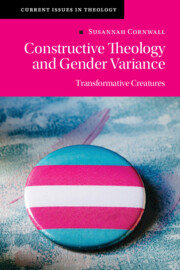Book contents
- Constructive Theology and Gender Variance
- Current Issues in Theology
- Constructive Theology and Gender Variance
- Copyright page
- Dedication
- Contents
- Acknowledgements
- Part I Setting the Scene
- Part II Telling Truths
- Part III Limits, Technology, and Health
- 7 Technological Interventions and Licit Limits
- 8 Trans People, Health, and Diversities of Order
- 9 Fertility, Generativity, and Gender Theology in the Optative Mood
- Part IV Transformative Creatures
- References
- Author Index
- Subject Index
7 - Technological Interventions and Licit Limits
On the Alteration and Augmentation of Bodies
from Part III - Limits, Technology, and Health
Published online by Cambridge University Press: 14 December 2022
- Constructive Theology and Gender Variance
- Current Issues in Theology
- Constructive Theology and Gender Variance
- Copyright page
- Dedication
- Contents
- Acknowledgements
- Part I Setting the Scene
- Part II Telling Truths
- Part III Limits, Technology, and Health
- 7 Technological Interventions and Licit Limits
- 8 Trans People, Health, and Diversities of Order
- 9 Fertility, Generativity, and Gender Theology in the Optative Mood
- Part IV Transformative Creatures
- References
- Author Index
- Subject Index
Summary
Reservations about the licit limits of technological transformation for trans people’s bodies are frequently grounded in convictions about created givenness and the desire to ensure that the body is a truthful and authentic expression of God-given identity. In this account, whilst the ostensible argument might be that bodies are irreducible and that spirit/mind/identity must supervene on them (such that where there is dysphoria minds must change to fit bodies), in fact there is a hidden appeal to a spirit and body which are mutually ‘fitting’ and coexist. Thus, in some conservative evangelical and conservative Roman Catholic accounts, commitment to the stability and reality of feminine and masculine gender means female and male bodies must not be altered. Bodily dimorphism is, in this account, significant because it points to broader truths about dimorphism that somehow precede actual concrete bodies (such that where an anomaly such as intersex arises it may or even must be corrected to ensure no physical variation from the binary lines; Hollinger 2009, p. 84; Congregation for Catholic Education 2019, pp. 13–14). Many trans people have appealed to the amelioration of distress that became possible for them when, post-transition, it no longer felt as though their body and spirit were in opposition.
- Type
- Chapter
- Information
- Constructive Theology and Gender VarianceTransformative Creatures, pp. 185 - 217Publisher: Cambridge University PressPrint publication year: 2022



